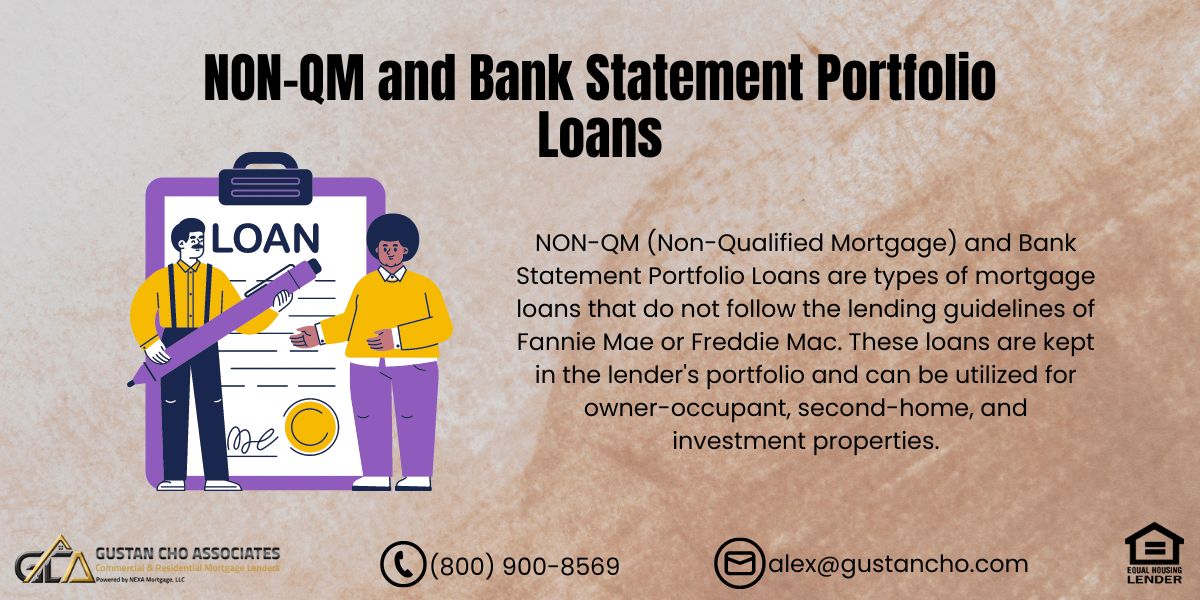-
How Does Bank Statement Loans Work
Posted by George on June 24, 2024 at 7:00 pmI am not familiar with bank statement loans. Can you please explain how bank statement loans work.
Susan replied 11 months, 2 weeks ago 8 Members · 8 Replies -
8 Replies
-
Bank statement loans are mortgages that allow borrowers to qualify based on their bank statements rather than traditional income documentation. Here’s an overview of how they typically work:
Purpose: These loans are often used by self-employed individuals, freelancers, or others with non-traditional income sources who may need help qualifying for conventional mortgages.
Income Verification: Instead of using tax returns or W-2 forms, lenders review 12-24 months of bank statements to verify income.
Calculation Method: Lenders usually calculate income by averaging deposits over the period provided, often excluding large, one-time deposits.
Business vs. Personal Accounts: Some lenders may require personal and business bank statements for self-employed borrowers.
Higher Down Payments: These loans often require larger down payments than conventional mortgages, typically 10-20% or more.
Higher Interest Rates: Due to perceived higher risk, interest rates on bank statement loans are usually higher than conventional mortgages.
Debt-to-Income Ratio: Lenders still consider the borrower’s debt-to-income ratio but calculate it based on bank statement income.
Credit Score Requirements: A good credit score, often 620 or higher, is typically required.
Cash Reserves: Borrowers may need to show significant cash reserves, often several months of mortgage payments.
Loan Limits: These loans may have lower maximum loan amounts than conventional mortgages. It’s important to note that bank statement loans are considered non-qualified and may not offer the same protections as qualified mortgages. Borrowers should carefully review terms and consider consulting with a financial advisor before proceeding. Visit us at Gustan Cho Associates:
https://gustancho.com/bank-statement-loans-for-self-employed-borrowers/
gustancho.com
Bank Statement Loans For Self-Employed Borrowers
12 Bank Statement Loans For Self-Employed Borrowers does not require tax returns. 12 months deposits is averaged and used as the income
-
Bank statement loans are a type of mortgage loan designed for self-employed borrowers, freelancers, and business owners who may need traditional forms of income documentation, such as W-2s or tax returns, to verify their income. Instead, these loans use the borrower’s bank statements to assess their income and ability to repay the loan. Here’s a detailed explanation of how bank statement loans work:
How Bank Statement Loans Work
Income Verification:
- Bank Statements: Lenders use personal or business bank statements instead of traditional income verification to determine the borrower’s income. Typically, lenders will look at 12 to 24 months of bank statements.
- Deposits Analysis: The lender reviews the deposits into the bank accounts to calculate the borrower’s monthly income. This helps establish a consistent income flow, demonstrating the ability to repay the loan.
Qualifying Criteria:
- Credit Score: While credit score requirements vary by lender, a minimum score of around 600-620 is often required.
- Down Payment: A larger down payment may be required compared to traditional loans, often ranging from 10% to 20%.
- Reserves: Lenders may require proof of reserves, such as savings or other liquid assets, to ensure the borrower can cover several months of mortgage payments if needed.
Types of Eligible Accounts:
- Personal Bank Statements: These are used for individuals who mix personal and business finances.
- Business Bank Statements: These are used for separate business accounts. Lenders may apply an expense ratio to account for business expenses, reducing the qualifying income.
Documentation:
- Bank Statements: 12 to 24 months of consecutive bank statements.
- Other Documents: Depending on the lender, additional documentation may include proof of business ownership, a profit and loss statement, and possibly a letter from an accountant.
Loan Terms of Bank Statement Loans:
- Interest Rates: Interest rates for bank statement loans are generally higher than those for conventional loans due to the higher risk associated with alternative income verification.
- Loan Amount: Loan amounts can vary but typically align with conventional loan limits.
- Repayment Period: Standard repayment periods (15, 20, 30 years) similar to conventional loans.
Benefits of Bank Statement Loans
Flexibility: Ideal for self-employed borrowers who may have difficulty documenting income through traditional means.
Accessibility: Provides an alternative for those with substantial cash flow but lack standard income documentation.
Quick Approval: This can sometimes be approved faster than traditional loans due to the streamlined documentation process.
Considerations and Potential Drawbacks
Higher Costs: Interest rates and fees may be higher than traditional mortgage loans.
Down Payment Requirements: Larger down payments might be necessary.
Complexity: The application process can be complex, requiring detailed bank statement analysis and possibly additional documentation. Bank statement loans offer a valuable solution for self-employed individuals and business owners who might not qualify for conventional loans due to a lack of traditional income documentation. By leveraging bank statements to verify income, these loans provide a pathway to homeownership for those with non-traditional income sources.
https://gustancho.com/non-qm-and-bank-statement-portfolio-loans/
gustancho.com
NON-QM and Bank Statement Portfolio Loans
NON-QM and bank statement portfolio loans allow non-QM loans one day out of BK and foreclosure, asset depletion, bank statement loans
-
Thank you for providing this comprehensive overview of bank statement loans. You’ve covered the key aspects thoroughly, and I agree with the information you presented. To add value to this discussion, I’ll highlight a few additional points and potential considerations:
Regulatory Landscape:
- Bank statement loans are typically considered non-qualified mortgages (non-QM), which means they don’t meet the strict criteria set by the Consumer Financial Protection Bureau (CFPB) for qualified mortgages.
- This classification can affect lenders and borrowers regarding legal protections and potential risks.
Underwriting Process:
- The underwriting for these loans can be more subjective and vary significantly between lenders.
- Some lenders may use automated systems to analyze bank statements, while others rely on manual review processes.
Industry Trends:
- The availability of bank statement loans can fluctuate with market conditions and economic factors.
- During economic uncertainty, lenders may tighten their criteria for these loans or limit their availability.
Alternative Options:
- Borrowers might also consider other non-traditional mortgage options, such as asset depletion loans or portfolio loans, depending on their financial situation.
Long-term Financial Planning:
- While bank statement loans can provide access to homeownership, borrowers should consider the long-term implications, including how it might affect their ability to refinance.
Debt-to-Income (DTI) Ratio:
- Lenders may calculate DTI differently for bank statement loans than traditional mortgages, potentially using a more conservative approach.
Seasoning Requirements:
- Some lenders may require that a business has been operational for a minimum period (e.g., two years) before considering a bank statement loan.
These additional points underscore the complexity of bank statement loans and the importance of borrowers fully understanding the terms and implications before proceeding. As with any financial product, potential borrowers should carefully weigh the pros and cons and consider seeking advice from a financial professional.
https://www.gcamortgage.com/bank-statement-mortgage-loans/
gcamortgage.com
Self-employed borrowers income is calculated by averaging the latest 12 months of deposits on bank statement mortgage loans. Taxes not required
-
Thank you for providing that information about bank statement loan requirements. You’re correct that the requirements can vary, but your overview aligns with general industry standards. Let me expand on this and provide a more comprehensive list of typical requirements for bank statement loans:
Credit Score:
- As you mentioned, a minimum score of 620 is often required
- Scores of 700 or higher typically qualify for better rates and terms
Bank Statements:
- Usually, 12-24 months of personal or business bank statements
Down Payment:
- Often 10-20% or more, with larger down payments potentially required for lower credit scores
Debt-to-Income (DTI) Ratio:
- Generally, it should be 50% or lower, though this can vary by lender
Cash Reserves:
- Typically, 3-6 months of mortgage payments in reserve
Business Documentation:
- Proof of business ownership (for self-employed borrowers)
- Sometimes, a Profit and Loss statement
Property Requirements:
- The property must meet the lender’s standards for value and condition
Employment Verification:
- Proof of self-employment for at least two years is often required
Loan-to-Value (LTV) Ratio:
- Often capped at 80-90%, depending on the lender and other factors
Income Calculation:
- Lenders typically use 50-100% of deposits as qualifying income, depending on the type of business
It’s important to note that these requirements can vary significantly between lenders. Some may have stricter criteria, while others might be more flexible. Borrowers should compare offers from multiple lenders to find the best terms for their situation. Also, while bank statement loans can be a valuable option for self-employed individuals or those with non-traditional income, they often come with higher interest rates and fees than conventional mortgages. Potential borrowers should carefully consider the long-term costs and implications before proceeding.
https://non-qmmortgagebrokers.com/bank-statement-loans/
non-qmmortgagebrokers.com
Self-employed borrowers can qualify without income taxes with bank statement loans for a home mortgage by averaging the 12 months of deposits
- As you mentioned, a minimum score of 620 is often required
-
Thank you for providing that information about bank statement mortgage loan requirements for self-employed borrowers. You’re correct that the bank statement details are crucial. Let me expand on this and provide a more comprehensive list of typical requirements:
Bank Statements:
- As you mentioned, lenders typically require:
- The statement date
- Total number of days in the statement period (or beginning and ending dates)
- Beginning and ending balance of the account
- Usually, 12-24 months of statements are required
- Statements should be complete with no missing pages
Business Documentation:
- Proof of business ownership (e.g., business license, tax ID number)
- Sometimes, a Profit and Loss statement
Credit Score:
- Often a minimum of 620, with better terms for scores of 700+
Down Payment:
- Typically 10-20% or more
Debt-to-Income (DTI) Ratio:
- Usually, it should be 50% or lower
Cash Reserves:
- Often, 3-6 months of mortgage payments in reserve
Length of Self-Employment:
- Typically, at least two years in the same business
Property Requirements:
- The property must meet the lender’s standards
Income Calculation:
- Lenders often use 50-100% of deposits as qualifying income
Explanation of Large Deposits:
- I may need to explain any unusually large deposits
Personal Tax Returns:
- Some lenders may still request 1-2 years of personal tax returns
Remember, requirements can vary significantly between lenders. Self-employed borrowers should compare offers from multiple lenders and consider consulting with a mortgage professional to find the best option. For more information about bank statement loans for self-employed borrowers, please visit FHA BAD CREDIT LENDERS at
https://fhabadcreditlenders.com/non-qm-loans/
fhabadcreditlenders.com
Non-QM Loans - FHA Bad Credit Lenders
Bank statement, 1099 Income Only, DSCR. Asset-Depletion, stated-income, ITIN, condotel financing, and no-Doc loans are all non-QM loans.
-
Bank statement mortgage loans are designed to help self-employed borrowers who may need traditional income documentation like W-2s or pay stubs. Here are the typical requirements for such loans:
Basic Requirements
Bank Statements:
- Duration: Usually, lenders require 12 to 24 months of personal or business bank statements.
- Account Information: Statements must include the account holder’s name, account number, statement date, beginning and ending balances, and details of deposits and withdrawals.
Income Calculation:
- Personal Bank Statements: Lenders typically add up the total deposits and average them over the statement period. Non-business-related deposits may be excluded.
- Business Bank Statements: Lenders often apply an expense ratio (typically 50%) to the total deposits to estimate the borrower’s net income.
Credit Score:
- A minimum credit score of 600 to 620 is generally required. However, some lenders have higher requirements depending on the loan amount and other factors.
Down Payment:
- Typically, a down payment of 10% to 20% is required. The exact amount may vary based on the lender’s policies and the borrower’s financial profile.
Reserves:
- Lenders might require borrowers to have reserves equivalent to several months of mortgage payments in savings or liquid assets.
Documentation:
- Proof of Business Ownership: A business license, incorporation articles, or an accountant’s letter.
- Profit and Loss Statement: Sometimes required to supplement bank statements.
- Identification: Valid government-issued ID.
Debt-to-Income Ratio (DTI):
- Lenders will calculate the DTI ratio using the income derived from bank statements. The maximum allowable DTI ratio is usually around 43-50%.
Property Requirements:
- The financed property must meet the lender’s type, location, and condition criteria.
Steps to Apply for a Bank Statement Mortgage Loan
Gather Documentation:
- Collect 12-24 months of consecutive bank statements.
- Ensure all statements are complete and show detailed transaction histories.
Contact Lenders:
- Reach out to lenders that offer bank statement loans. It’s beneficial to consult with mortgage brokers who can compare multiple lenders.
Submit Application:
- Fill out the loan application and submit all required documentation.
Income Calculation:
- Work with the lender to verify the calculated income based on bank statement deposits.
Loan Approval Process:
- The lender will review your application, credit history, and financial documents. They may ask for additional information during underwriting.
Loan Closing:
- Once approved, proceed with the closing process, including signing the loan agreement and paying any required closing costs.
Bank statement mortgage loans are tailored for self-employed individuals who find it challenging to qualify for traditional loans due to a lack of conventional income documentation. By providing bank statements that show a steady flow of deposits, borrowers can demonstrate their ability to repay the loan.
-
Bank statement loans is a form of non-qm loans for self employed borrowers with little to no income on their income tax returns. Self employed individuals who do not have adjusted gross income on their federal income tax returns can qualify for bank statement loans for self employed borrowers with credit scores down to 600 at Gustan Cho Associates. Here’s a article about bank statement loans for self employed borrowers.
https://fhabadcreditlenders.com/bank-statement-loans/
fhabadcreditlenders.com
Bank Statement Loans For Self-Employed Borrowers
Bank statement loans for self-employed borrowers with no income tax returns, 12 months deposit in bank statements are averaged for income.
-
Bank statement mortgage loans are designed for self-employed individuals or those with inconsistent income who may struggle to qualify for traditional mortgages. The only difference between a one-year and two-year bank statement loans is the length of bank statements needed as proof of income. Here’s how they compare:
One-Year Bank Statement Mortgage
Verification: 12 months’ personal and business bank statements must be submitted by the applicant to prove their earnings.
Calculation: Lenders assess average monthly incomes throughout past year on basis of revenue collected in these accounts.
Eligibility: Suitable for borrowers with a stable but limited income history.
Pros:
Faster Processing Time: Less paperwork means quicker approvals.
Consideration Of Recent Earnings Surge: This is helpful when an individual has experienced an increase in pay within the last few months or so.
Cons:
Greater Risk For Lenders: Shorter periods could make some lenders view them as risky, leading to higher interest rates and more strict terms being imposed by such lenders.
Two-Year Bank Statement Mortgages
Verification: In order to verify their income, applicants need to present two years’ worths of personal and business bank statements.
Calculation: Borrowers’ monthly revenues are averaged over 24 months by examining deposits shown on these papers according to most lending companies’ policy manuals’.
Eligibility Requirements/Who It Is Best Suited For?: This type of mortgage suits those who have had longer working histories with consistent salaries earned from steady employment sources like full/part-time jobs; freelancing work would not be considered here because there might not always be contracts signed between clients & contractors thus making it difficult for lenders to establish if one has been generating income during that time period
Pros:
More Stability Indicated By Applicant’s Finances Over A Longer Period Of Time Which Could Result In Better Loan Terms Being Offered By Lending Institutions;
Reduced Perceived Risk By Lenders Due To Additional Documentation Required Over A Longer Timeframe, Which May Translate Into Lower Interest Rates Being Charged By The Lenders Themselves
Cons:
Time Consuming: The process of collecting and going through two years’ worth of bank statements can be lengthy.
Past Earnings Effect: If an applicant earned less money during any particular month within the last 24 months, this will bring down their average monthly income figure calculated by a lender when assessing how much they can afford to borrow against such income.
Major Differences To Consider When Choosing Between These Two Mortgages Are As Follows:
Loan Terms – because lenders consider twenty-four months as being more stable than only twelve months’ worth of earnings from self-employed borrowers they may offer longer term lengths on loans if someone chooses a two-year bank statement mortgage over its alternative;
Interest Rates – rates charged by financial institutions providing these products are usually higher for one year banking statements rather that two year ones due to perceived greater risk involved with short-term employment contracts which do not guarantee regular payments into accounts held at those banks.
Qualification – some people might qualify for a single-year but not a two-year home loan given that there has been recent improvement in their income situation;
Documentation – obviously there is much more paperwork required when processing requests involving 24-months compared with just 12 month’s worth of earnings data provided by applicants so be prepared for additional effort and time spent gathering all necessary documents together before submitting them along with your application form.
Which One Should I Go For?
One Year Bank Statement Mortgage: Ideal if you’ve had significant rises in pay lately or need quick approval timescales which come along with fewer forms being filled out plus supporting documents having to supplied like tax returns etc..
Two Year Bank Statement Mortgages : Best suited towards individuals who can show consistent levels.






